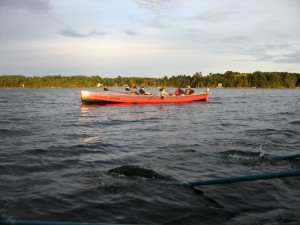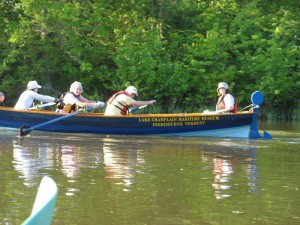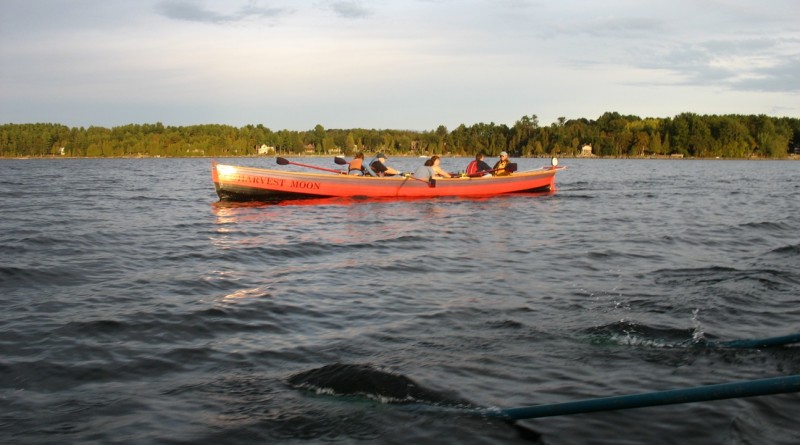Community Rowing | Boaters Meet for Fitness and Friendship
An osprey screeches as a red, orange, and yellow boat nears its nest.

“Let’s give the bird some space,” coxswain Matt Witten says to his six rowers. “Starboard, hold water, port, give me a few strokes. Ready all and row.” The craft pivots and slips away.
It’s Thursday evening and conversation floats up from three wooden longboats gliding over Otter Creek in Ferrisburg. This is Community Rowing, a program of the Lake Champlain Maritime Museum of Ferrisburgh. Two evenings each week, Monday in Burlington and Thursday at the museum, rowers from 20-somethings to nearly 70, chat, sightsee, and learn the lore of the lake.
 From late April until fleeting evenings of October, the museum’s longboats welcome adults with no affiliation other than an interest in exercise and the lake. Some participants row a few times each year, others weekly. No experience is necessary. After a quick explanation new rowers take their seats beside more experienced hands, pulling one long oar in rhythm with the coxswain’s call.
From late April until fleeting evenings of October, the museum’s longboats welcome adults with no affiliation other than an interest in exercise and the lake. Some participants row a few times each year, others weekly. No experience is necessary. After a quick explanation new rowers take their seats beside more experienced hands, pulling one long oar in rhythm with the coxswain’s call.
In May, I joined the group for an outing. The flooded Otter Creek ignored its boundaries, giving community rowers a blank canvas for an evening outing.
“Shall we row over the road, through the woods, or across farm fields?” Maple’s coxswain Ben Mayock asks. Soon the colorful boats weave through forests and cattail marshes enroute to the main channel of the creek.
“Shall we visit Snake Den Cove or Button Island?” coxswain Ed McGuire asks Osprey’s crew. They decide to cross to the Palisades on the New York shore and stop in a sheltered harbor for a swim.
“Rowing is great exercise and the scenery is unbeatable,” says Jake Mathon, who works from home in Williston for a virtual consulting and business intelligence firm. “During the season, we visit a range of destinations. Even the drive to Basin Harbor is beautiful…. My company encourages us to find out-of-home activities. It’s important for me to get out and interact with people.”
Mary Miklaus, who teaches at Beeman Elementary School in New Haven, had similar sentiments. “I love the trickling sound as the boat glides, then the splash of six oars in unison,” she says. “Rowing is a great workout. Even when I’m exhausted and want to stop, I know others are counting on me.”
◊ ◊ ◊
Champlain Longboats are built, one per year, at LCMM by non-traditional high school students. Recently, Community High School of Vermont students completed a boat. CHSV is an accredited school within Vermont’s Department of Corrections working with pupils who are incarcerated or on parole. Constructed from 250-year-old designs, the gigs are copies of pilot boats that escorted ships along the coast of Cornwall. Working with a forester, the students select trees from Vermont Family Forests (an organization working towards use of sustainable, local wood products). At the museum, they use a portable sawmill to cut the lumber. This wood dries while the builders construct their boat with planks chosen two years previously. After five months of work under the guidance of LCMM’s Nick Patch, the students choose a name and color scheme for their boat. Parading with bagpipe accompaniment to Basin Harbor, they launch the new gig. Retired sweep oars from college crew teams are the only non-traditional materials in the 1,000-pound, 32-foot boats.
“The design of these boats connects us with our ancestors, going back to the Greeks and the Phoenicians,” says coxswain Witten, a writer and storyteller. For nearly two decades Witten has helped build boats and lead trips for the museum. Known as the Champlain Troubadour, Witten occasionally sings a sea chantey from his perch in the stern.
Ben Mayock leads the Monday rows in Burlington. “I enjoy watching all of the activity, he says. “It’s a contrast with the quiet beauty near Basin Harbor.”
The rowers lift their oars from the water and the boat stops beside a yellow buoy floating near the breakwater. “This marks a horse-powered ferry hundreds of feet below,” Mayock says. “There’s a replica at the museum,” he adds. “Sit ready, ready all, and row.”
The boat slides away.
◊ ◊ ◊
Many of the coxswains bring decades of experience on the water. As a teenager, Witten sailed from New York to Leningrad, Russia, on a 150-foot sailboat. He was also boatswain—that’s nautical-speak for a carpenter—on Pete Seeger’s Clearwater that plied the Hudson River advocating for clean water.
Mayock led sea-kayaking trips for many years and teaches Paddling Ecology at LCMM. McGuire, a retired Coast Guard officer, has rowed and paddled since childhood, including summer cruises to Europe and rowing at sea while at the Coast Guard Academy. As a volunteer, McGuire has helped build four of the LCMM longboats.
“I love teaching seamanship to kids,” he says. McGuire is central to maintenance of the fleet. “There is always cleaning, repairing, and painting to do in the off-season.”
Returning from an evening row, the Spirit of Otter Creek threads its way into Burlington Harbor. “Let it run,” Mayock tells the crew. “Does this guy see us?” The rowers turn to see a motorboat heading straight at them, all four heads in the craft looking away.
“Hey!” Mayock yells. The driver grabs the wheel and jerks his boat out of Otter Creek’s path.
“You’re faster than you look,” the skipper says as Otter Creek floats past, oars raised high to avoid a collision. In fact, a good crew of six can move at 6 knots!
Barbara Thomke rows occasionally. “I love the rhythm, the tug of water against your muscles,” she says. “The air is fresh and I feel connected to the water, lake, outdoors, exercise, and beauty. It’s a great way to spend an evening.”

